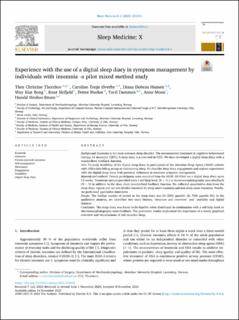| dc.contributor.author | Thorshov, Thea Christine | |
| dc.contributor.author | Øverby, Caroline Tonje | |
| dc.contributor.author | Hansen, Diana Dobran | |
| dc.contributor.author | Bong, Way Kiat | |
| dc.contributor.author | Skifjeld, Knut | |
| dc.contributor.author | Hurlen, Petter | |
| dc.contributor.author | Dammen, Toril | |
| dc.contributor.author | Moen, Anne | |
| dc.contributor.author | Hrubos-Strøm, Harald | |
| dc.date.accessioned | 2024-01-19T08:36:48Z | |
| dc.date.available | 2024-01-19T08:36:48Z | |
| dc.date.created | 2023-12-20T09:28:30Z | |
| dc.date.issued | 2023 | |
| dc.identifier.citation | Sleep Medicine: X. 2023, 6 . | en_US |
| dc.identifier.issn | 2590-1427 | |
| dc.identifier.uri | https://hdl.handle.net/11250/3112676 | |
| dc.description.abstract | Background: Insomnia is the most common sleep disorder. The recommended treatment is cognitive behavioural
therapy for insomnia (CBTi). A sleep diary is a core tool in CBTi. We have developed a digital sleep diary with a
standardised feedback function.
Aim: To study feasibility of the digital sleep diary in participants of the Akershus Sleep Apnea (ASAP) cohorts
with difficulties falling asleep or maintaining sleep. To describe sleep diary engagement and explore experiences
with the digital sleep diary with potential influences in insomnia symptom management.
Material and methods: Twenty participants were recruited from the ASAP. All filled out a digital sleep diary up to
12 weeks. Treatment options provided were a self-help book (N = 11) or electroencephalography neurofeedback
(N = 9) in addition to the sleep diary standardised feedback function. We collected quantitative data from the
sleep diary reports and we sub-divided insomnia by sleep onset insomnia and non-sleep onset insomnia. Finally,
we performed qualitative interviews.
Results: The median number of entries to the sleep diary was 81 (25th quartile: 26, 75th quartile 84). In the
qualitative analysis, we identified two main themes; “structure and overview” and “usability and digital
features”.
Conclusion: The sleep diary was found to be feasible when distributed in combination with a self-help book or
electroencephalography neurofeedback. The qualitative results emphasised the importance of a timely graphical
overview and visualisations of self-recorded sleep. | en_US |
| dc.language.iso | eng | en_US |
| dc.rights | Navngivelse 4.0 Internasjonal | * |
| dc.rights.uri | http://creativecommons.org/licenses/by/4.0/deed.no | * |
| dc.title | Experience with the use of a digital sleep diary in symptom management by individuals with insomnia -a pilot mixed method study | en_US |
| dc.type | Peer reviewed | en_US |
| dc.type | Journal article | en_US |
| dc.description.version | publishedVersion | en_US |
| cristin.ispublished | true | |
| cristin.fulltext | original | |
| cristin.qualitycode | 1 | |
| dc.identifier.doi | 10.1016/j.sleepx.2023.100093 | |
| dc.identifier.cristin | 2216031 | |
| dc.source.journal | Sleep Medicine: X | en_US |
| dc.source.volume | 6 | en_US |
| dc.source.pagenumber | 7 | en_US |

